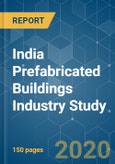The concept of prefabrication is gaining prominence in the Indian construction market. The entry of prefabricated homes in India has paved the way to innovative and technologically advanced construction and design methods for all kinds of construction, such as high rises, low rises, villas, and mass townships.
India is comparatively backward and slow in incorporating prefab constructions into the real estate market. According to an industrial source, India has only around 1-2% of prefabricated buildings, out of its more than USD 100 billion real estate market. One of the main reasons for low penetration of prefabrication solutions in India is a mindset blockade in India, with most developers averse to investing in modular methods of construction and hesitant to incorporate prefabrication in their new and ongoing projects.
There is a big opportunity for prefab companies in India and hundreds or thousands of plants are expected to be required in the future. Over the next few years, India would feature among the fastest-growing countries in terms of construction output, making the technology intervention a key component. India is expected to become the third largest construction market in the world by 2025.
The construction sector in the country is expected to expand to a size of USD 1 trillion, over the next decade, and contribute over 15% to GDP. Given the high anticipated growth of the Indian construction industry, during the forecast period, the prefabricated structures are expected to gain popularity. Slated to have the world’s third largest construction industry by 2025, India is witnessing a high uptake of modular techniques with its construction sector slowly transforming and behaving more like the business of manufacturing.
The government is taking major steps to strengthen the infrastructure for the ever-growing population. In a country which is already congested with its high population, there is a need to build mass housing to make homes for 900 million more people by 2050. In the top seven cities alone, the demand is estimated to increase by 32% year-on-year as of 2019.
Key Market Trends
Government Initiatives in Infrastructure and Construction Sector to Boost the Industry
The demand for infrastructure in India is at an all-time rise. As the government is now looking towards accelerating the growth of infrastructure in India, it has given approval for Real Estate Investment Trust (REIT) to help investors come forward to invest in the Indian real estate market, thus creating an opportunity worth USD 19.65 billion in the Indian market over the coming years. Through GHTC- I, Global Housing Technology Challenge, the government plans to bring the latest technologies in the construction sector.
Through the Smart-Cities mission, the nation aims to create sustainable world-class cities and has allocated a budget of USD 29.2 billion. As of Jun 2020, 75% of the projects planned were completed with USD 16.5 billion in investments. Through HRIDAY, a scheme to develop the heritage cities, an amount of USD 16.5 million has been approved by the central government. With many other initiatives and plans by the government like AMRUT, PMAY (Pradhan Mantri Awas Yojana, a national housing scheme), the infrastructure and construction sector is set to see a rapid growth which in many ways boosts the prefabrication industry.
Precast Concrete Holds Largest Share in the Market
Precast concrete holds the largest share in the market driven by the increase in the off-site construction activity. The rampant infrastructure development held by the government in the country has driven the high demand for supporting materials such as concrete which is also quite large. It is also expected to exhibit growth with a rise in non-residential and residential construction due to rising urbanization.
The precast concrete construction technology is one of the most promising solutions to deal with the rising demand for housing and infrastructure construction. Cement production is reached 337.32 million tonnes in 2018-19 and stood at 278.79 million tonnes from April 2019-January 2020. According to data released by the Department for Promotion of Industry and Internal Trade (DPIIT), cement and gypsum products attracted Foreign Direct Investment (FDI) worth USD 5.28 billion between April 2000 and December 2019.
Currently, 67% of housing accounts for the biggest consumption of cement and concrete, followed by infra at 13%, commercial real estate at 11%, and industrial real estate at 8 %. To meet this rising demand for precast materials cement companies are expected to increase capacity to over 56 metric tonnes next three years. Many factors like increasing urbanization, growing population and rising focus of government on infrastructural development are driving India ready mix concrete market.
Competitive Landscape
The report covers the major players operating in the India Prefabricated Buildings Industry. The market is highly competitive with no major players. The market is fragmented, and the market is expected to grow during the forecast period due to the increase in the prefab construction building investments and up-coming major projects in the country and other few factors are driving the market.
Prefabricated building systems and construction hold high potential to improve the efficiency and performance of the Indian construction industry in a more sustainable sense. L&T, one of the biggest companies in the construction sector in India, signed an MoU with the US-based engineering company KBR for the construction of modular process plants for refinery and petrochemical projects.
Reasons to Purchase this report:
- The market estimate (ME) sheet in Excel format
- 3 months of analyst support
Table of Contents
Companies Mentioned (Partial List)
A selection of companies mentioned in this report includes, but is not limited to:
- EVEREST INDUSTRIES LIMITED
- LARSEN AND TOUBRO LIMITED
- PARAMOUNT BUILDING SOLUTIONS PRIVATE LIMITED
- BALARKA FABRICON PRIVATE LIMITED
- NCC LIMITED
- Interarch
- Simplex Infrastructures
- EPack Prefab
- Champion Prefabs *








